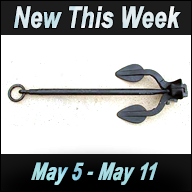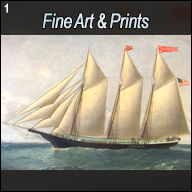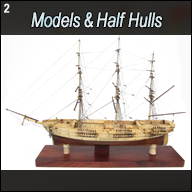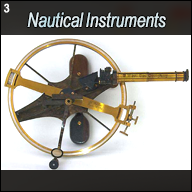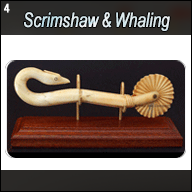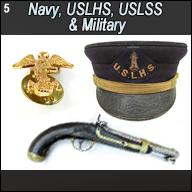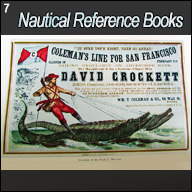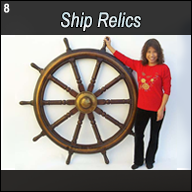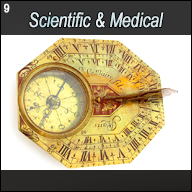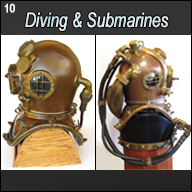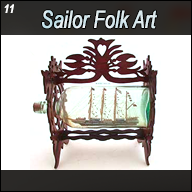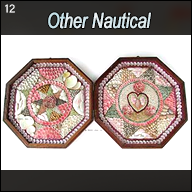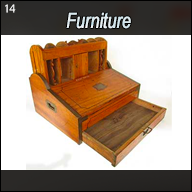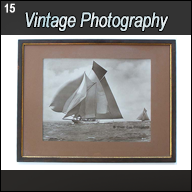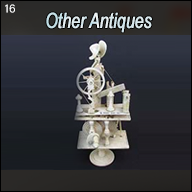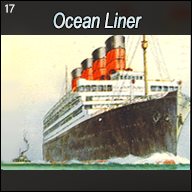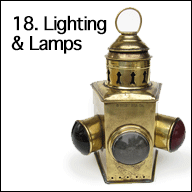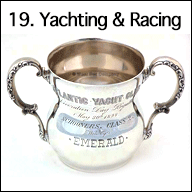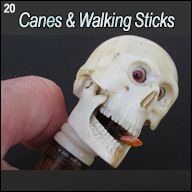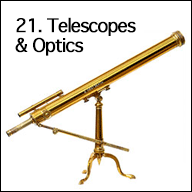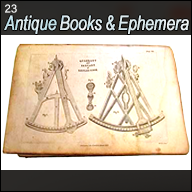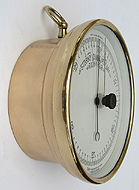22. Barometers:
Prices in U.S. Dollars are listed in GREEN.
 |
 |
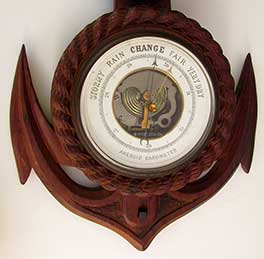 |
| clock | barometer |
 |
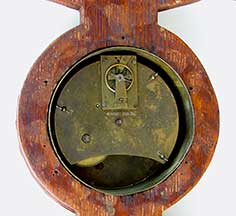 |
| registry mark | movement |
 |
| back |
Order Info
 |
22.58 ESPECIALLY NICE BAROMETER. Early 1900’s German aneroid barometer made for the American market signed “The Standard Weather Bureau Service Co., Inc.” as marked on the dial. The bottom reads “Made In Germany” (pre-War). This particularly handsome barometer has an open face showcasing the complicated movement within. The dial is of porcelain colorfully marked with the standard weather notations in fancy script “Stormy, RAIN, Change, FAIR and Very Dry.” The atmospheric pressure is calibrated in inches of mercury from 27.5 to 31.5 in 2/100th increments marked by tenths. A delicate blued steel indicator needle points to the current reading overlaid by a brass set needle with knurled knob which records the previous reading. The dial is protected by its very thick beveled glass crystal set within a brass reflector ring. The case of the barometer is solid bronze. A significant aspect of this barometer’s extra appeal is the fact that it can be displayed in 2 ways. There is a pivoting suspension loop at the top for hanging. OR, it can be displayed on a desk or shelf supported on its 2 attached feet. The dial is 5 inches in diameter. The barometer body is 5 3/8 inches wide by 2 inches deep and stands 6 inches tall inclusive of the loop. Excellent original condition throughout. The barometer function is lively and accurate. This is a winner! 549 |
 |
 |
| perspective | back |
Order Info
 |
22.55 SAILING SHIP BAROMETER. Noticeably scarce, genuine 19th century ship’s barometer housed in its protective wooden cabinet. This unusual presentation consists of an aneroid (without liquid) weather barometer in its brass case with white enameled dial under glass. Its wide scale is calibrated in inches of mercury from 24 to 31 divided in 2/100th increments. It bears the standard weather indications reading “STORMY, Much Rain, Rain, CHANGE, Fair, Set Fair and VERY DRY.” The reading is pointed by a fine blued steel indicator needle overlaid by a brass set needle with knurled knob, rove through the beveled glass to track changes. The bottom of the dial is marked “HOLOSTERIC BAROMETER” and bears the circular trademark “PNHB,” that of the most famous and prolific French barometer maker Paul Naudet, Paris. The back of the brass case is similarly marked. The case has a suspension loop at the top which engages a small hook on the inside of the cabinet. The unique wooden cabinet is beautifully hand-made of solid teak with decorative parquetry sections. This is NOT a production item, but was most certainly made on board the ship by its skilled carpenter! It has a old wooden door inset with wavy glass, hinged on the right, opening on the left, secured with a brass hook and eye. The top of the case has a thickt brass hanging bracket. The barometer itself measures 5 inches in diameter. The cabinet is 7 ¾ inches wide by 8 ½ inches tall and 5 inches deep. Outstanding original condition in all respects. The barometer is functional and accurate. Without a doubt this is the most unusual ship’s barometric item we have encountered in our 40 + years. 895 Why a sailing ship barometer? Steamships of the late 1800’s into the early 1900's had enclosed pilot houses and chart rooms protected from the harsh environment of the open sea. On the otherhand, wooden sailing ships were far more exposed to the damp, wind and extremes of temperature – all of which adversely affected the accuracy of a barometer. This marvelous custom-made cabinet was truly a bit of genius. It is rare, both in its uniqueness and its survival! Any knowledgeable maritime collector adds a feather in his/her cap with this acquisition. A true museum piece at a very, very resonable price in these infrlationary times! Go buy gas! |
 |
 |
| perspective | back |
 |
 |
| open | interior |
 |
| dial |
Order Info
 |
22.57 BOSTON BAROMETER. Outstanding late 1800’s ship’s aneroid barometer made y the prestigious Paris firm of Paul Naudet for the early ship chandlers Advance Nautical Equipment Co. as marked on the dial. In full, the inscription reads “ADVANCE NAUTICAL INSTRUMENT CO. 154 STATE STREET BOSTON MADE IN FRANCE, HOLOSTERIC BAROMETER, Naudet (PNHB) & Cie.” The perfect white enameled dial indicates the atmospheric pressure in inches of mercury from 24 to 31 inches in 2/100th increments. It is marked “STORMY, RAIN, CHANGE, FAIR and VERY DRY.” The reading is pointed by a blued steel indicator needle, atop which is the brass set needle with knurled knob rove through the beveled glass crystal. The barometer case is rich bronze in its original finish. The back is additionally marked (PNHB) along with a small aperture for setting the barometer movement. A pivoting suspension loop is provided at the top for hanging. This instrument is in an outstanding state of original preservation, belying its 140+ year age. The barometer function is guaranteed to be lively and accurate. A scarce example of an early Boston ship chandler item. 495 The Advance Nautical Instrument Company’s address was just a few doors down from the very famous 19th century Boston instrument making firm of Samuel Thaxter and Son who were located at 125 State Street since 1826. The innovative and prolific Paris aneroid barometer maker, Pierre (alternatively "Paul”) Naudet began his firm in 1861 and continued producing aneroid barometers into the 1930's. The date and meaning of the markings HBPN (alternatively PNHB) is not thoroughly understood. Andy Demeter, in his book “Chelsea Clock Company The First One Hundred Years “ notes, "With the possible exception of recording barometers, Chelsea did not assemble holosteric or aneroid movements for their barometers preferring to purchase them from the legendary French maker, Pierre (alternatively Paul) Naudet. His firm's trademark is typically found in a circle on these early barometer dials with the letters "HBPN" as an abbreviation for "Holosteric Barometer, Pierre Naudet." A barometer dial on page 220 is pictured with the caption, "1909 Pierre Naudet barometer." (See Item 22.56) |
 |
 |
| perspective | back |
Order Info
 |
22.56 BOSTON BAROMETER with THERMOMETER. Exquisite ship’s barometer and thermometer made by the Parisian barometer maker Paul Naudet for the highly regarded Boston opticians “PINKHAM & SMITH COMPANY IMPORTERS BOSTON” as boldly marked on the center of the dial. This particularly pristine example of a late Victorian barometer has a lovely silvered brass dial reading in inches of mercury atmospheric pressure from 27.8 to 31.2 in 2/100ths increments. The standard weather indications “STORMY, RAIN CHANGE FAIR, VERY DRY” are indicated. Above the center arbor it reads “HOLOSTERIC (PNHB) Made In France BAROMETER.” Of special added value is the large, curved mercury thermometer at the bottom of the dial marked “FAHRENHEIT THERMOMETER.” It is calibrated in 2 degree increments from 22 to 120. The instrument measures 5 inches in diameter and 2 inches thick. It stands 5 7/8 inches tall inclusive of the hanging loop. Outstanding original condition is all respects. The barometer and thermometer functions are amazingly responsive and accurate. 595 (See item 22.57) |
 |
 |
| perspective | back |
Order Info

|
22.54 HYGROMETER/THERMOMETER. Highest quality West German hygrometer with an applied alcohol-in-glass thermometer. The hygrometer registers percent of atmospheric humidity from 0 to 100, indicated by a precise arrowhead needle. The curved thermometer mounted on milkglass indicates the ambient temperature in degrees Fahrenheit from -26 to 122 in 2 degree increments marked by 20's. The all brass case is in a lustrous finish. Three mounting holes are on the flanged back which measures 6 inches in diameter. The silver dial is 4 ½ inches across. Excellent functional condition. WAS $295 NOW! 99 |
perspective |
dial |
Order Info

|
22.47 RARE WEST COAST BAROMETER. Very finest quality aneroid barometer with the silvered brass dial signed "LOUIS WEULE Co. SAN FRANCISCO." The near perfect open face dial is marked in inches of atmospheric pressure from 25 to 32 in 2/100th increments marked by tens and in whole inches. It bears the classic bold weather indications "STORMY RAIN CHANGE FAIR and VERY DRY." At the bottom of the dial it is marked "Holosteric (PNHB) Barometer." The barometer reading is shown by the delicate blued steel indicator needle. The dial is protected by a beveled glass crystal with brass set needle rove through the glass, connected to a fine knurled brass knob. The beautiful, complex inner workings of the movement appear through the large central aperture. The solid bronze case is in excellent original condition with a mellow patina acquired over the last 100 years. The back is stamped (PNHB). At the top is a substantial pivoting suspension loop for hanging. 5 ¼ inches in diameter by 2 inches thick. 6 ¼ inches tall overall, inclusive of the suspension loop. Still functioning perfectly and very accurate. As clean and as original as they come! 495 |
dial detail |
back |
Order Info

|
22.44 CASED ALTIMETER/BAROMETER. Extra large cased turn-of-the-century gentleman's pocket altimeter and barometer. This English-made piece is signed in script with the retailer's name "Adolf Frese, Los Angeles." This impressive precision instrument is of the very highest quality, featuring an aneroid barometer movement connected to a very fine indicator needle. The lovely silvered brass dial is calibrated in atmospheric pressure in inches of mercury from an amazing 20.08 to 31 in 5/100th increments marked by whole inches. Encircling this readout is the altimeter scale which reads from 0 to 10,000 calibrated in 50 foot increments. The precision of the delicate needle is such that an extrapolated reading with a finer accuracy can be observed. The dial is also marked "Compensated" which means it is corrected for temperature changes. The beveled glass crystal protects the dial and is seated in the rotating knurled bezel which indicates the altitude at any given reading. The heavy, solid brass case is in its original gilt brass finish. This barometer is equipped with a folding suspension loop at the top and an adjustment feature on the back for setting the accuracy of the reading. It fits neatly into its wooden case covered in rich Moroccan leather, lined in silk and satin. The case hinges on the left and closes on the right with a spring-load button latch. This represents the largest of its type of "pocket barometer" ever made. It measures 2 7/8 inches in diameter and 7/8 inches thick. Rare to find in such good overall condition. 695 |
case |
dial |
back |
Order Info

|
back |
detail |
dial |
mechanism |
thermometer |
set needle knob |
Order Info

|
22.40 BAROGRAPH. Superb quality, third quarter 19th century British recording barometer by one of the most famous makers of the era, “LENNIE EDINBURGH” as engraved on the bedplate. This precision scientific instrument is as lovely as it is accurate. The complex solid brass mechanism is gold washed. It consists of a stack of 8 flexible aneroid bellows attached to a linkage which transfers motion to an inking stylus at the end of a long metal trace. The bellows expand and contract with changes in atmospheric pressure, the extent of which are measured on the revolving clockwork drum. To set the reading a knurled thumbscrew is at the top of the cross bar of the support columns. A long arm attached to a knurled knob on the bedplate allows the trace to be disconnected from the drum when not in use. The drum is encompassed by an interchangeable paper chart calibrated in barometric inches of mercury from 28 to 31 in 5/100th increments on the a axis. The x axis is calibrated in days of the week divided by 2 hour intervals. The bottom of the chart is signed “LENNINE 40 PRINCESS STREET EDINB.” Inside the drum a jeweled clockwork with built-in winding key revolves the drum precisely once a week to produce a continuous and accurate record of atmospheric changes. These observations were important for the British Meteorological Office (the “Met” formed in 1854) to help forecast weather at sea for the safety of seamen. To these ends a large number of blank and actual inked charts are contained in a drawer below. The mechanism is housed in a handsome splined solid mahogany case with thick beveled glass on all 5 sides. An articulated brass arm allows the case to be opened and held in place while servicing. A small bottle of special red recording ink is held in its receptacle. The entire unit measures 14 ½ inches long by 9 inches wide and 8 3/8 inches tall. Outstanding original condition. The clockwork has just been fully serviced by a professional watchmaker. 1495 |
open |
open reverse |
detail |
clockwork |
drum |
movement |
movement reverse |
drawer |
signature |
Order Info
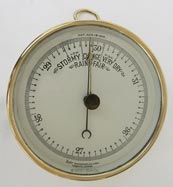
|
22.19 MOUNTAIN BAROMETER. Scarce early 1900’s American-made aneroid barometer for use at altitude. This lovely precision weather instrument has a white enameled brass dial protected by a glass face. The bottom of the dial is signed “Taylor Rochester, N.Y. U.S.A. / Toronto, Canada.” At the top it is marked “PAT. AUG. 18-1914.” The dial is calibrated in inches of mercury reading from 26 to 31 in tenths of inches, divided by 2/100ths. It is also marked with the standard weather indications “~STORMY – RAIN –CHANGE * FAIR – VERY DRY~.” A blackened steel indicator needle points to the precise reading, overlaid by a brass set needle connected to a knurled brass knob through the glass. The barometer is contained within its lovely solid bronze case with pivoting suspension loop at the top. The unique feature of this barometer is on the back. Rotating the knurled brass plate moves the entire movement within, thus setting the reading for a given altitude. The rim of the plate is calibrated in “FEET” of altitude from “3500 to 7000” in 100 foot increments. Instructions read “ROTATE THIS PLATE UNTIL ARROW ON CASE POINTS TO THE ALTITUDE OF YOUR LOCALITY. PATENTED AUGUST 18-1914.” 5 ¼ inches in diameter and 2 ½ inches deep. 6 ¼ inches tall overall including the suspension loop. This fine instrument is fully functional and in a virtually pristine state of original preservation. 349 |
PerSpectivE |
back |
Order Info

|
22.24 “MOUNTAIN” BAROMETER. Quite scarce early 1900’s American “Mountain Barometer” with the unique feature of being adjustable for altitude (elevation). This precision instrument was made by the Tycos Company of Rochester, N.Y. as signed on the bottom of the white enameled dial. The dial is calibrated for atmospheric pressure in inches of mercury spanning the wide range from 25 to 31 inches in 2/100th increments marked by 10’s. It bears the standard weather indications “@STORMY @ RAIN, CHANGE * FAIR @ VERY DRY @” with the added notations “LOW & HIGH.” At the top it is marked “PAT. AUG.-18-1914.” The reading is indicated by a fine blued steel needle overlaid by a brass “set needle” with knurled brass knob rove through the beveled glass cover. The body of this instrument is solid bronze in its original flawless golden lacquer finish. The back of this instrument bears the rare patented feature which allows it to be adjustable. It consists of a knurled disc calibrated in feet of elevation from 0 to 3,500. The engraved instructions read, “FOR A SEA LEVEL READING ROTATE THIS PLATE UNTIL THE ARROW ON THE CASE POINTS TO THE ALTITUDE OF YOUR LOCALITY.” The back also has an aperture for a set screw to further adjust the movement. The top is equipped with a pivoting brass loop for hanging. 5 ¼ inches in diameter and 6 inches high overall. Absolutely perfect condition is all respects. The precise mechanism is lively and accurate. The best! 395 |
perspective |
dial |
back |
(See also item 22.19)
Order Info

|
22.27 FRENCH BROMETER with THERMOMETER. Finest quality late 19th century aneroid barometer made by the highly respected Parisian barometer making firm of Paul Naudet as indicated on the small “PNHB” logo at the top of the dial. This handsome example has a silvered open face which frames the complex movement within. The dial indicates atmospheric pressure in inches of mercury calibrated from 27.8 to 31.2 in 2/100th increments marked by 10ths. It shows the standard weather indications of “STORMY, RAIN, CHANGE, FAIR and VERY DRY.” At the top of the aperture it is marked “Made In France” and “HOLOSTERIC BAROMETER” (without liquid). Of much added value and desirability is the fact it is fitted with a large curved mercury tube marked “FAHRENHEIT THERMOMETER” registering an exceptionally broad range of -18 to 148 degrees in 2 degree increments. The barometric read-out is made by the very precise blued steel indicator needle, overridden by the brass set needle attached to a knurled knob. The knob runs through the beveled glass crystal with its old wavy glass. The solid rose bronze case is of traditional form with a pivoting suspension loop at the top for hanging, but also fitted with a stout brass hanger for hard mounting to the ship’s bulkhead top and bottom. This lovely antique barometer has just been professionally serviced and both functions are guaranteed to be lively and accurate. 5 ¼ inches in diameter, 2 1/8 inches deep and 6 1/8 inches high overall. In our 35 years handling antique barometers, there are no finer examples than those marked PNHB. For an accurate, functional instrument which is very decorative and has value as an antique, this is it! The best. 595 The first practical aneroid ("without liquid") barometer is generally attributed to Parisian, Lucien Vidie in 1843, who was awarded an English patent for his device in 1844. Vidie's patent rights expired in 1859, allowing other makers to produce instruments. The most successful makers in France were Naudet, Hulot & Cie, who reportedly made 20,000 instruments between 1861 and 1866. (1) Another reference to the firm was made by Middleton who states, "...there were several makers soon after the patent expired in 1859, the most successful being Naudet, Hulot, & Cie. According to Le Roux they made 20,000 aneroid barometers between 1861 and 1866. They called them baromètres holostériques... references occur in the continental literature to Naudet barometers and to holosteric barometers for the rest of the nineteenth century. They acquired a great reputation and were widely imitated." (2) Middleton goes on to state, "For many purposes aneroids continued to be made - and are indeed still made - of a form very like that arrived at by Naudet, Hulot & Cie about 1860." (3) In the Appendix is an entry for a barometer held in the collection of the Smithsonian Institution, Washington, D.C. It reads, "230,002 A "Holosteric Barometer- Compensated, "made by Naudet & Co. Marked on the back of the case, U.S. Signal Service" (4) indicating manufacture around the time of the First World War. Surprisingly, little is written about the innovative and prolific Paris aneroid barometer maker, Pierre (alternatively "Paul”) Naudet, although it is known that his firm was begun in 1861 and continued producing aneroid barometers into the 1930's. The dating and meaning of the markings HBPN (alternatively PNHB) are less clear. An entry for a barometer sold on eBay indicates the markings refer to "Hulot, Pertius & Naudet, Paris, barometer makers in the 1930's. However Andy Demeter, writing about the history of the Chelsea Clock Company notes, "With the possible exception of recording barometers, Chelsea did not assemble holosteric or aneroid movements for their barometers preferring to purchase them from the legendary French maker, Pierre (alternatively Paul) Naudet. His firm's trademark is typically found in a circle on these early barometer dials with the letters "HBPN" as an abbreviation for "Holosteric Barometer, Pierre Naudet." (5) On page 220 a barometer dial is pictured with the caption, "1909 Pierre Naudet barometer." 1. Edwin Banfield, "Barometers Aneroid and Barographs," 1985, Baros Books, Wiltshire, England, p. 21. 2. W.E. Knowles Middleton, "The History of the Barometer," 1964, The Johns Hopkins Press, Baltimore, p. 407. 3. Ibid. p. 409. 4. Ibid. p. 464. 5. Andrew Demeter, "Chelsea Clock Company, The First Hundred Years," 2001, Demeter Publications, Ltd., Boston, Massachusetts, p. 221. |
perspective |
dial |
back |
Order Info

|
22.06 ANTIQUE BAROGRAPH. Extraordinary, scientific grade turn-of-the-last-century weather instrument made by the well known English makers “Short & Mason, London.” This lovely, fully functional instrument embodies the long-standing British penchant for form and function. As such, the precision mechanism with gilded brass works and hardwood housing is a thing of beauty. It employs 12 evacuated silvered bellows connected with a complex linkage system to a stylus holding an inking pen. The linkage is all brass with steel pivots as mounted to the gilded brass bedplate. It is decoratively-engraved with its makers, “Short & Mason London.” The quill-type pen records a trace on the revolving drum. A lever mounted on the front of the bedplate allows the pen to be lifted from the drum when not in use. The brass drum is turned by a jeweled clockwork mechanism which runs for 8 days on a single wind, making one revolution per week. To these ends there is a Fast/Slow adjustment feature under the removable brass cover and a separate winding key. The interchangeable chart paper graph encompassing the drum is marked from 28 to 31 inches of barometric pressure in 1/10th increments on the “y” axis and is marked Monday through Sunday in 2 hour increments on the “x” axis. The glazed wooden case is made of rich mahogany with all brass fittings and is supported on 4 wooden feet. The sturdy scalloped base is complete with pull-out drawer containing 2 compartments. The forward compartment is filled with original, unused gummed graph charts. In addition there is an original pamphlet reading “S and M STORMGRAPH RECORDING BAROMETER, Directions For Use.” The second compartment is for storing recorded charts. The upper removable case contains its original old glass on all 5 sides. This instrument measures 14 3/8 inches long by 8 ½ inches wide and 8 1/2 inches high. Complete with the original ink vile with ground glass stopper and contents! The entire presentation is in an outstanding state of original preservation, fully functional (the clock keeps good time) and is complete with at least 20 spare recording charts in pristine original condition. Price Request |
OPEN |
DETAIL |
MOVEMENT |
DRAWER |
SIGNATURE |
Order Info

|
22.09 WEATHER GLASS. Authentic hand-blown glass weather instrument known as a weather glass, storm glass or thunder glass, as found in the homes of sea captains from the 17th through the19th centuries. This exacting copy consists of a one piece glass vial with a hanging eye at the top, a curved swan’s neck spout, and terminates in a bulbous glass bottom. It is complete with a hand-wrought hanging bracket of copper and brass. In use the glass is partially filled with water so that the level can be seen within the spout. Weather changes accompanied by varying atmospheric pressure are evident in the rise and fall of the water level in the spout. The hanging bracket measures 12 inches tall overall and the glass is 9 inches tall and 3 ½ inches wide. Perfect condition. 49 |
GLASS |
INSTRUCTIONS |
PLATE |
Order Info

|
22.13 BAROMETER / ALTIMETER. Large, extra nice late 19th century English gentleman’s traveling barometer with the dual function of being an altimeter. This unusually large portable instrument is in the form of a pocket watch with bow and retains its bright brass finish. The silvered brass dial is hand-engraved. It is calibrated from 25.5 to 31 inches of barometric pressure, divided down to 2/100ths of an inch. It is marked “Compensated” and “Made in England” The outer rim of the dial is marked in “FEET” from 0 to 5,000 divided down to amazing 20 foot increments! To set and record a reading the rim revolves. This is provided with pinpoint accuracy by the extremely fine steel indicator needle which is little more than a hair’s width in diameter! This instrument is complete within its silk and satin-lined, hinged wooden case with Moroccan leather cover. A small spring-loaded lever with brass button latch secures the case when closed. 3 ¼ inches in diameter and 1 ¼ inches thick. The dial itself measures 2 ½ inches across. Fully functional and accurate. 595 |
 |
|
BACK |
CASE |
 |
|
IN CASE |
CASE OPEN |
Order Info

